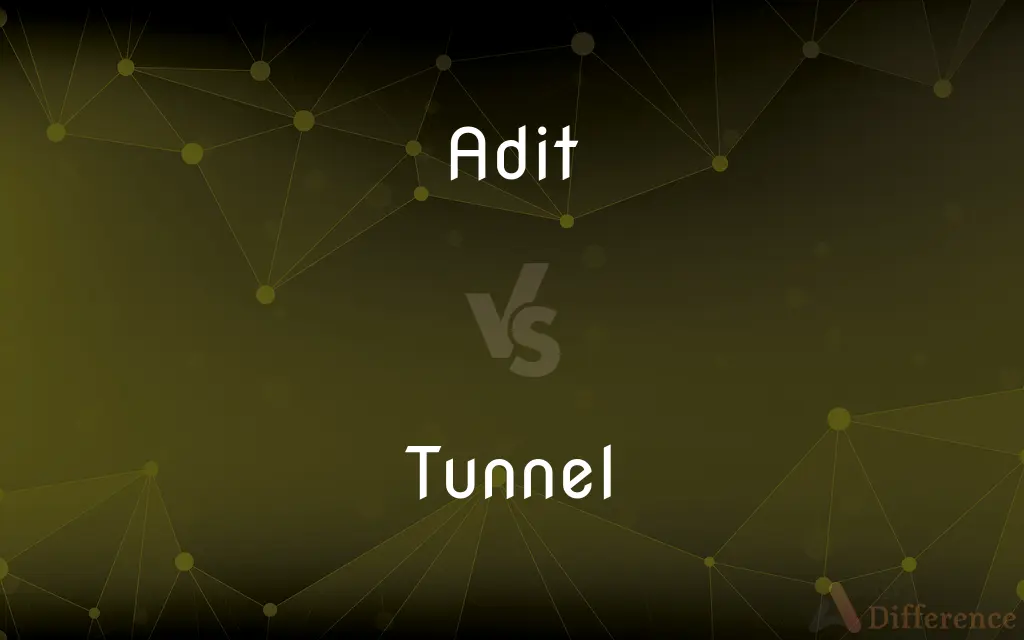Adit vs. Tunnel — What's the Difference?
By Maham Liaqat & Urooj Arif — Updated on March 25, 2024
An adit is a horizontal passage leading into a mine for access or drainage, whereas a tunnel is a passageway dug through the earth or rock to allow passage from one side to another, often used for transportation.

Difference Between Adit and Tunnel
Table of Contents
ADVERTISEMENT
Key Differences
Adits are specifically constructed for the mining industry, serving primarily as entrances to underground mine workings. Tunnels, on the other hand, serve a broader range of purposes, including transportation (for cars, trains, and pedestrians), water conveyance, and as utility conduits. They can be horizontal, vertical, or inclined and are not limited to mining applications.
While adits are open on one end where they connect to the surface and the other end extends into a mine, tunnels typically have an entrance and an exit that both open to the surface, or they connect two open spaces. This structural difference highlights the adit's role in providing access and drainage to mines, whereas tunnels create a passageway through obstacles like mountains, water bodies, or urban infrastructure.
The construction of adits involves considerations unique to mining, such as ore body location, geology, and hydrology, to ensure they efficiently serve their purpose of access, ventilation, and drainage. Tunnel construction, however, often requires advanced engineering techniques to address challenges posed by longer distances, deeper excavations, and the need to support surrounding structures, emphasizing its versatility and complexity.
Adits, by nature, are closely tied to the lifecycle of the mine they serve. Once the mining operation ceases, the adit may be sealed or abandoned. Tunnels, in contrast, are designed for long-term use and can serve as critical infrastructure components for centuries, reflecting their importance in connecting and sustaining communities.
The engineering and design philosophies behind adits and tunnels also differ. Adits are designed with a focus on practicality and efficiency in mining operations, prioritizing easy access and effective drainage. Tunnels, however, must balance engineering challenges with the safety and comfort of their users, incorporating ventilation, emergency exits, and sometimes even aesthetic considerations into their design.
ADVERTISEMENT
Comparison Chart
Purpose
Access and drainage for mines
Passage through obstacles for various uses
Orientation
Horizontal or nearly so
Any orientation, including horizontal and vertical
Construction Site
Mines
Urban areas, mountains, under water bodies
Lifespan
Tied to the mine's operation
Long-term, often permanent infrastructure
Design Focus
Efficiency in mining operations
Safety, durability, user comfort
Compare with Definitions
Adit
Facilitates water drainage from mines.
The adit successfully diverted groundwater away from the mine workings.
Tunnel
Can be used for transportation or utility services.
The new rail tunnel reduced travel time significantly.
Adit
Specifically designed for the mining industry.
Adits provide essential ventilation to underground miners.
Tunnel
Connects two open spaces.
The underwater tunnel connects two islands.
Adit
A horizontal passage into a mine for access or drainage.
The mining company dug an adit to reach the coal seam.
Tunnel
A passageway through or under an obstacle.
The tunnel connected the city to the airport.
Adit
Often abandoned after the mine closes.
The old adit was sealed once the mine ceased operations.
Tunnel
Requires advanced engineering and safety measures.
The tunnel's design includes state-of-the-art ventilation systems.
Adit
Serves as an entrance or exit for miners and equipment.
Miners entered the mountain through the adit.
Tunnel
Designed for long-term public and commercial use.
The tunnel has been a vital part of the region's infrastructure for decades.
Adit
An adit (from Latin aditus, entrance) is an entrance to an underground mine which is horizontal or nearly horizontal, by which the mine can be entered, drained of water, ventilated, and minerals extracted at the lowest convenient level. Adits are also used to explore for mineral veins.
Tunnel
A tunnel is an underground passageway, dug through the surrounding soil/earth/rock and enclosed except for entrance and exit, commonly at each end. A pipeline is not a tunnel, though some recent tunnels have used immersed tube construction techniques rather than traditional tunnel boring methods.
Adit
An almost horizontal entrance to a mine.
Tunnel
An artificial underground passage, especially one built through a hill or under a building, road, or river
The Mersey tunnel
A road tunnel through the Pyrenees
The tunnel mouth
Adit
A horizontal or nearly horizontal passage from the surface into a mine, as contrasted with a shaft or vertical entry passage. An adit may be used for ventilation, haulage, drainage, or other purposes.
Tunnel
Short for wind tunnel
Adit
An entrance or passage. Specifically: The nearly horizontal opening by which a mine is entered, or by which water and ores are carried away; - called also drift and tunnel.
Tunnel
A long, half-cylindrical enclosure used to protect plants, made of clear plastic stretched over hoops
Cover plants in rows with a cloche tunnel
Adit
Admission; approach; access.
Yourself and yours shall haveFree adit.
Tunnel
Dig or force a passage underground or through something
The insect tunnels its way out of the plant
He tunnelled under the fence
Adit
A nearly horizontal passage from the surface into a mine
Tunnel
(of a particle) pass through a potential barrier.
Tunnel
An underground or underwater passage.
Tunnel
A passage through or under a barrier such as a mountain.
Tunnel
A tube-shaped structure.
Tunnel
To make a tunnel through or under
Tunneling the granite.
Tunnel
To produce, shape, or dig in the form of a tunnel
Tunnel a passageway out of prison.
Tunnel
To make a tunnel.
Tunnel
An underground or underwater passage.
Tunnel
A passage through or under some obstacle.
Tunnel
A hole in the ground made by an animal, a burrow.
Tunnel
A wrapper for a protocol that cannot otherwise be used because it is unsupported, blocked, or insecure.
Tunnel
A vessel with a broad mouth at one end, a pipe or tube at the other, for conveying liquor, fluids, etc., into casks, bottles, or other vessels; a funnel.
Tunnel
The opening of a chimney for the passage of smoke; a flue.
Tunnel
(mining) A level passage driven across the measures, or at right angles to veins which it is desired to reach; distinguished from the drift, or gangway, which is led along the vein when reached by the tunnel.
Tunnel
(figurative) Anything that resembles a tunnel.
Tunnel
(transitive) To make a tunnel through or under something; to burrow.
Tunnel
(intransitive) To dig a tunnel.
Tunnel
To transmit something through a tunnel (wrapper for insecure or unsupported protocol).
Tunnel
To insert a catheter into a vein to allow long-term use.
Tunnel
(physics) To undergo the quantum-mechanical phenomenon where a particle penetrates through a barrier that it classically cannot surmount.
Tunnel
A vessel with a broad mouth at one end, and a pipe or tube at the other, for conveying liquor, fluids, etc., into casks, bottles, or other vessels; a funnel.
Tunnel
The opening of a chimney for the passage of smoke; a flue; a funnel.
And one great chimney, whose long tunnel thenceThe smoke forth threw.
Tunnel
An artificial passage or archway for conducting canals, roads, or railroads under elevated ground, for the formation of roads under rivers or canals, and the construction of sewers, drains, and the like.
Tunnel
A level passage driven across the measures, or at right angles to veins which it is desired to reach; - distinguished from the drift, or gangway, which is led along the vein when reached by the tunnel.
Tunnel
To form into a tunnel, or funnel, or to form like a tunnel; as, to tunnel fibrous plants into nests.
Tunnel
To catch in a tunnel net.
Tunnel
To make an opening, or a passageway, through or under; as, to tunnel a mountain; to tunnel a river.
Tunnel
To make a tunnel; as, to tunnel under a river.
Tunnel
A passageway through or under something, usually underground (especially one for trains or cars);
The tunnel reduced congestion at that intersection
Tunnel
A hole in the ground made by an animal for shelter
Tunnel
Move through by or as by digging;
Burrow through the forest
Tunnel
Force a way through
Common Curiosities
What makes tunnel construction challenging?
Tunnel construction faces challenges like geological variability, water handling, and ensuring structural stability over long distances and depths.
What is the main difference between an adit and a tunnel?
The main difference is their purpose and design: adits are for mine access and drainage, while tunnels provide passageways for various applications.
Can a tunnel serve the same purpose as an adit?
While tunnels can be used in mining, adits are specifically designed for horizontal access and water drainage in mines.
Are adits safe to explore?
Adits can be dangerous due to potential collapses, lack of oxygen, and toxic gases, and should not be explored without proper expertise and equipment.
How are tunnels built under water bodies?
Tunnels under water are built using techniques like immersed tubes or boring through the bedrock, requiring advanced engineering to prevent water ingress and ensure structural integrity.
How do adits contribute to mine safety?
Adits contribute to mine safety by providing ventilation, reducing the risk of flooding, and offering additional exit routes in case of emergency.
Why are tunnels important for urban development?
Tunnels facilitate the efficient movement of people and goods, reduce surface congestion, and connect disparate parts of urban environments.
Can an adit be converted into a tunnel?
While technically feasible, converting an adit into a tunnel would require significant modification to meet the structural and safety standards of tunnels.
What happens to adits when mines close?
They are often sealed to prevent access and mitigate environmental hazards, though some may be repurposed for tourism or historical preservation.
What are some iconic tunnels around the world?
Examples include the Channel Tunnel between the UK and France, the Gotthard Base Tunnel in Switzerland, and the Seikan Tunnel in Japan, showcasing engineering marvels in tunnel construction.
Share Your Discovery

Previous Comparison
Counsel vs. Barrister
Next Comparison
Cupcake vs. MuffinAuthor Spotlight
Written by
Maham LiaqatCo-written by
Urooj ArifUrooj is a skilled content writer at Ask Difference, known for her exceptional ability to simplify complex topics into engaging and informative content. With a passion for research and a flair for clear, concise writing, she consistently delivers articles that resonate with our diverse audience.















































